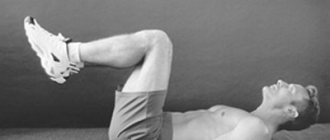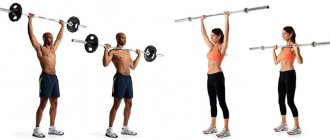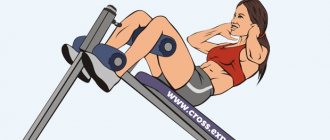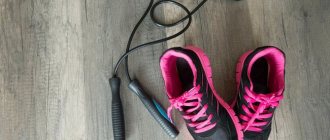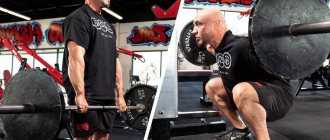For at least the last decade, a number of fairly well-known and authoritative methodologists in the field of “natural” bodybuilding have strongly recommended training one muscle group more often than with a traditional weekly split, that is, more than once a week. Usually it is a recommendation to repeat the load every third or fourth day. The main message to increasing the frequency of training is that each training helps to enhance muscle protein synthesis, namely, it stimulates the formation of NEW protein structures. An increase in the rate of synthesis is observed within two to three days after training, after which it becomes sluggish. That is, when training a muscle group once a week, out of seven days it actively grows only two or three. If, after a drop in the rate of protein synthesis, a repeated load is carried out, then growth will accelerate again (growth of new protein structures) and, thus, the muscle will grow actively almost all week. This promises much faster progress. However, not everyone manages to get good results in practice. If we do not take into account those athletes who have already exhausted their potential for muscle growth (and it is clearly not infinite), then one of the main reasons for the lack of progress with more frequent training is overload. Excessive metabolic stress during training prevents the full stimulus that was provided by training the same muscle group a few days ago. Moreover, frequent high-intensity loads begin to “wear out” the joints.
There may be other explanations for this, but the fact remains: trying to train twice a week intensively (with heavy weights) and in volume causes stagnation, and sometimes regression. However, the author has personally observed in practice on the example of many, both men and women, that loading one muscle group every third or fourth day can significantly accelerate progress in comparison with the classic once-a-week regimen. Therefore, it’s worth trying, but the main thing is to observe only two conditions:
- The load on one muscle group per workout should not be voluminous.
- The load mode should alternate every workout.
Let's look at each of the two points in a little more detail.
What does it mean that the load should not be volumetric?
This means that the amount of work done by the muscle group should not be large. The concept of “big” is very subjective, but with full-fledged work to failure, you can identify specific numbers that a number of methodologists adhere to. This is 4-6 working approaches per muscle group per workout. TOTAL, in total 4-6, and not in one of the exercises. I’m clarifying this specifically because misunderstandings always arise here. The more repetitions you plan to perform in an exercise, the fewer approaches there should be and vice versa. For example, for a range of 5-6 repetitions, you can perform 6 sets, for a range of 12-15, perform 4 sets. When working in basic multi-joint exercises that involve several muscle groups, consider one-to-one approaches only for the dominant group. That is, when performing, for example, squats, you expose the load to both the front and back surfaces of the thigh. However, few people get both of these muscle groups the same stimulus.
In most cases, the quadriceps receives the greatest stimulus, while the hamstrings are more likely to receive a toning, supporting load. Therefore, having done 4 sets of squats, you should take into account that these are 4 approaches specifically for the quadriceps, but the load on the hamstrings must be taken into account with a factor of 0.5. In this example, these are 2 approaches (0.5x4=2). That is, if in your leg training you planned to do 4 approaches each for the quadriceps and hamstrings, then having done, for example, 4 sets of squats, you will also need to do 2 approaches for the hamstrings and you can finish there. The situation is similar with other exercises. 4 basic exercises for the lats are 2 approaches for the biceps; after doing 4 exercises for the lats, you can “finish off” the biceps with two isolating approaches. In basic chest exercises (bench press, dips), having done 4 approaches, the triceps can be “finished off” with a couple of approaches and this will be enough. Many have long been practicing a similar approach to taking into account the volume of load in their training, based on the usual logic.
Training program
The effectiveness of the “1+1” program is that it allows beginners to increase their muscle mass in a short period of time.
Its essence is as follows : the loads during training are distributed over two halves of your body, that is, on the first day you use exercises on one half, then you rest one day, the next day you exercise the other half of the body. This system will be discussed in the article, since I believe that it is optimal for muscle development for beginners. The point of this training schedule is this : to begin with, we “divide” our body into two parts, and exercise only one part during training in the gym. This is followed by a day of rest. But if your age or busyness at work does not allow you, then you can use two days instead of one day of rest. This means that there will be either 3-4 or 2 workouts per week in the gym.
- First day : muscles of the legs, back and abdomen
- Second day : pectoral and shoulder muscles, arm muscles
After starting regular training with this program, it is recommended to stick to it for at least six months. Both beginners and advanced and experienced bodybuilders are accustomed to frequently changing their gym schedule because they believe that they find something better to strengthen their body. But, unfortunately, this is not the case. Frequently changing programs can lead to disruption of the training system, which is important. Therefore, I advise you to follow this program until you notice any progress.
- First day : no classes
- Second day : a) muscles of the legs, back and abdomen
- Third day : no classes
- Fourth day : b) pectoral and shoulder muscles, arm muscles
- Fifth day : no classes
- Sixth day : a) muscles of the legs, back and abdomen
- Seventh day : no classes
- Eighth day : b) pectoral and shoulder muscles, arm muscles
..and so on.
What does it mean that the load mode should alternate?
This means that one workout should be high intensity (5-6 repetitions), and the other moderate (12-15 repetitions). This is the simplest scheme and there is no need to complicate it, although other options are possible, which we will talk about next time. Such regimes not only stimulate muscle growth, activating various mechanisms of hypertrophy, but also have different effects on the body as a whole, on its endocrine system, joint-ligamentous apparatus (less intensity - less load).
Now let's move on directly to organizing the training process based on the above recommendations.
How to create conditions for muscle growth at work
As usual in the morning, you wake up and have breakfast , then another meal follows, after 2 hours , then the next one, also after 2 hours. The main principle of an athlete’s nutrition is reusability and balance .
In order not to constantly look at the clock, you can listen to your body , as soon as you begin to experience a slight feeling of hunger , immediately begin to eat. It is advisable to replace some meals with protein shakes.
At work, try not to overexert yourself ; if you have the opportunity not to waste physical strength, do not waste it, you will need it in the gym.
Healthy eating at work
Mental core work and training
If you work more with your head , for example, as an office employee who periodically strains his mental abilities, then in this case, you should also not get too tired, especially try to avoid severe stress , otherwise the nervous system will be overloaded, and you will feel overwhelmed and out of control during training. like a “lemon”, but this is not as scary as in cases of heavy physical work, which will inevitably lead the athlete sooner or later to overtraining .
Comments:
-High-intensity training consists mainly of basic exercises, resting between working sets for 3-4 minutes
-Medium-intensity load consists of isolating exercises, rest between working approaches is 1.5-2 minutes
-A similar microcycle can be repeated for 6-8 weeks, after which the necessary adjustments can be made. For example, add another day of rest between workouts, or add/reduce the number of approaches, change exercises. In any case, each example of a training program must be adapted to a specific “user”. It is best when a trainer deals with such correction.
Attention: Materials posted in this section may be published in whole or in part only with the obligatory indication of the source of the publication.
Lactic acid has nothing to do with it
It used to be that lactic acid was to blame for post-workout pain. However, this opinion was later proven to be wrong.
Lactic acid affects your muscles during training: it is what causes you to feel the burning sensation at the end of a difficult set. However, as soon as you stop exerting yourself, the blood begins to flush lactic acid from the muscles.
Scientists have proven Blood Lactate Measurements and Analysis during Exercise: A Guide for Clinicians that blood lactic acid levels reach a peak value 3-8 minutes after maximum effort and decrease to pre-exercise levels after 60 minutes. And because lactic acid leaves the muscles so quickly, it may have no effect on pain 1-2 days after exercise.
The break between training is from 2-3 months to a year
After a drop in strength indicators, muscle volume and strength endurance, changes begin at the level of the nervous system, muscle coordination worsens, and muscle tissue weakens even more.
The degree of deterioration depends on training experience; those who have been training for more than 10 years will experience fewer negative processes than those who have been training for 1-2 years. All this is due to the fact that the muscles get used to physical activity, strengthening them over the years, and this protection is more difficult to destroy.
When you constantly train, the correct execution of the movement becomes automatic, but over time this mechanism is forgotten and you must learn again, again learning the technique of movement. All this distracts muscle fibers from the final results, what kind of growth is there, if they are actually taught to work correctly.
As they say, “you can’t drink experience away,” so in your mind you will know how to do the exercise correctly, you just need to direct the power of thought in the right direction.
Therefore, a break for this period will reduce all your sports performance, you can resume them, but you will actually have to start from 0 , but again, this all depends on your training experience.
Nutrition after training for mass or relief
Nutrition greatly influences the results. If you go to the gym, train regularly, but don’t change your diet and diet, you will have to wait a long time for results, or you may not see them at all.
The difference in nutrition during training for mass and for relief is significant. During weight gain, the diet should be balanced. I am selected in such a way that there is a calorie surplus (exceeding the daily norm) . There are no strict restrictions during this period, but it is still worth maintaining a balance.
During relief training, a more strict approach to nutrition is taken. Carbohydrates and fats are slightly . So, thanks to nutrition along with training, it will be possible to get rid of a significant percentage of subcutaneous fat in a short period.
How to train correctly in the gym for a man
At the beginning of the journey, when motivation is overflowing and goals have been set, many begin to actively train. Unfortunately, this approach to the training process usually ends with the body becoming exhausted, burnout occurring, and training being abandoned. The dream of a slim, athletic body remains a dream. Such impulses can occur repeatedly, but results cannot be achieved in this way. Everything needs balance, so success depends on three components:
- regular classes on a correctly composed complex;
- balanced nutrition according to the regime;
- adequate sleep and rest.
In the pursuit of quick results, motivation is lost, so training should become a habitual way of life. Then you will be able to build the body of your dreams and maintain good physical shape.
When a person first comes to the gym, he has the following questions:
How often and for how long to train?
Before answering this question, let’s delve a little deeper into the topic – body types. The training process and nutrition are usually built based on this parameter. It is customary to distinguish three body types:
- ectomorph - a tall and thin person;
- mesomorph – average height, athletic build;
- endomorph - a short, well-fed (stocky) person.
In order for classes to be as effective as possible and nutrition to be beneficial, this structural feature should be taken into account.
If you are not going to participate in a bodybuilding championship, then 2-3 classes per week according to the training program in the gym for men with moderate load is enough. In this case, the complex should include strength exercises and cardio exercise. The training time will depend on your body type.
For an ectomorph, three classes a week are enough, with at least 48 hours of rest between classes. The strength part of the workout in the gym for men should take place at an intense pace, no more than 40 minutes.
for a mesomorph to gain muscle mass; 2-3 gym sessions per week, lasting 60-90 minutes, are also enough for him.
Endomorphs are more prone to obesity, so the training process should be based on good cardio and strength training with many repetitions. You can train 2-3 times a week for 50-70 minutes.
Where to start training in the gym?
Beginners often neglect warming up when they enter the gym and immediately start lifting weights. This is absolutely impossible to do. Before strength training, it is necessary to do warm-up exercises to avoid traumatic consequences.
At the very beginning of the workout, it is advisable to do light cardio for 10-15 minutes (treadmill, elliptical, exercise bike), and then prepare the ligaments and joints for work. For this, standard exercises familiar to us from school are suitable: rotation of the head, shoulders, hands, bending forward, squats without weight.
Once your body is warmed up, you can begin doing sets with weights. This will avoid injury and pain after exercise.
Features of training for mass or relief
Before you go to the gym, you should decide on your goals; what training program in the gym for men is used - for mass or for relief, they are radically different. Professional athletes prefer to alternate these periods in their lives: for several months, training and nutrition contribute to gaining mass (not only muscle), and then a drying period begins, which approximately lasts from 1.5 to 2 months.
At the same time, gaining weight and wanting a sculpted body with defined muscles is almost impossible. Therefore, it is better to alternate these stages. Mass training is dominated by basic exercises with heavy weights and low repetitions , some completely eliminate cardio so as not to burn the accumulated mass. In this mode, training can continue for several months.
Once the desired mass is gained, then through good cardio and training with high-repetition exercises with medium and light weights, subcutaneous fat is burned. Thus, the muscles that gained volume during the period of mass gain begin to appear.

